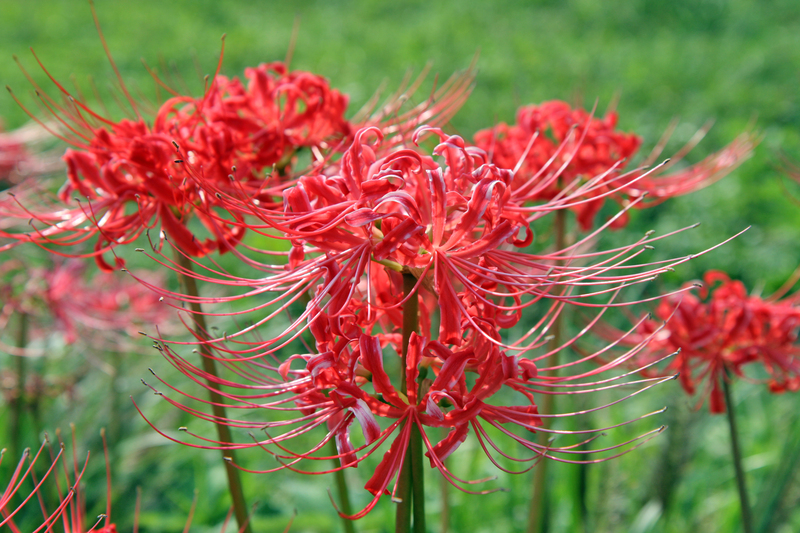Unlocking the Power of Waste for Soil Enrichment
Posted on 15/08/2025
Unlocking the Power of Waste for Soil Enrichment
In the quest for sustainable agricultural practices and environmental stewardship, waste management has emerged as a transformative solution for soil enrichment. By converting various types of organic and inorganic waste into valuable resources, we not only minimize environmental pollution but also nurture healthier and more fertile soils. This comprehensive guide explores the profound synergy between waste and soil health, unlocking strategies that maximize the value of materials once deemed useless.
Understanding Waste as a Resource
For decades, waste was perceived strictly as a problem to be disposed of, often relegated to landfills or incineration. However, with growing awareness of its potential, communities and industries are increasingly embracing the concept of unlocking the power of waste for soil enrichment. Let's delve deeper into the types of waste that hold the most promise for soil improvement:
- Organic Waste: Kitchen scraps, yard trimmings, crop residues, and manure.
- Industrial Byproducts: Fly ash, gypsum, and biochar from biomass power plants.
- Municipal Solid Waste Compost: Compost produced from sorted residential and commercial waste.
- Sewage Sludge (Biosolids): Treated municipal wastewater solids, safely processed to reduce pathogens.
The Importance of Soil Enrichment
Soil is the foundation of terrestrial life. Healthy soils boost agricultural productivity, enhance water retention, sequester carbon, and promote ecosystem biodiversity. Yet, intensive farming and poor waste management practices have led to widespread soil degradation. By leveraging waste for soil enrichment, we address these challenges through a circular approach -- returning organic and nutrient-rich materials back to the Earth.

Types of Waste Used for Soil Enrichment
1. Composting Organic Waste
*Composting* is one of the most accessible and effective methods for transforming kitchen and garden waste into valuable soil amendments. The decomposition process, driven by microorganisms, converts raw organic matter into stable humus, rich in nutrients and beneficial microbes.
- Key Benefits of Compost in Soil:
- Enhances soil structure
- Increases nutrient-holding capacity
- Introduces essential microbes
- Improves moisture retention
Unlocking the power of kitchen scraps for soil enrichment not only reduces landfill waste but provides a cost-effective, sustainable alternative to chemical fertilizers.
2. Agricultural and Livestock Waste
Farmers are rethinking the disposal of crop residues and animal manure. When properly managed, these resources reintegrate nutrients like nitrogen, phosphorus, and potassium back into the soil ecosystem.
- Crop residues serve as mulch and ground cover, minimizing erosion.
- Manure provides slow-release nutrients and organic matter.
- Digestate from anaerobic digesters offers pathogen-reduced, nutrient-rich soil additive.
3. Biochar: Ancient Method Meets Modern Science
*Biochar* is a carbon-rich product obtained from the pyrolysis of organic material under limited oxygen conditions. This charcoal-like substance was used by indigenous peoples to create *Terra Preta* -- fertile Amazonian soils that still retain their productivity centuries later.
- Enhances cation exchange capacity, improving nutrient availability
- Increases water retention
- Sequesters carbon, mitigating climate change
Incorporating biochar produced from agricultural waste presents a double benefit -- reducing waste streams and building resilient soils.
4. Municipal Waste Compost and Biosolids
With proper separation and treatment, municipal solid waste and biosolids can be repurposed for agriculture or landscaping. These processes must ensure the elimination of pathogens and heavy metals to guarantee safety for humans and the environment.
- Biosolids are rich in micro and macronutrients vital for plant growth.
- Municipal compost diverts waste from landfill, curbing methane emissions.
- Both contribute to the buildup of soil organic matter.
How Waste Enhances Soil Fertility and Health
Implementing waste-based soil enrichment methods delivers wide-ranging agronomic and environmental advantages:
- Boosts Soil Fertility: Adds nutrients that sustain crops and reduce reliance on synthetic fertilizers.
- Restores Soil Structure: Organic amendments increase porosity, promoting healthy root growth and infiltration.
- Supports Soil Microbiology: Diverse waste products foster beneficial microbes, crucial for nutrient cycling.
- Regulates Soil pH: Some waste applications can help buffer soil acidity or alkalinity.
- Retains Moisture: Soils high in organic matter hold water longer, reducing irrigation needs.
- Mitigates Pollution: Proper waste management cuts landfill and incinerator pollution, closing the nutrient loop.
Case Study: Community Composting for Urban Gardens
Many urban centers are pioneering community composting projects, transforming food scraps into "black gold" for gardens and city parks. In doing so, cities like San Francisco and Toronto dramatically reduce waste sent to landfills while yielding high-quality compost for local growers. These initiatives illustrate the practical impact of turning waste into soil enrichment resources.
Unlocking Waste Potential: The Science Behind Soil Enrichment
Soil is a living, dynamic system. To fully unlock the power of waste for enriching soil, we must appreciate a few scientific principles:
- Decomposition Dynamics: Microbes break down organic waste, releasing nutrients in mineral forms plants can absorb. The rate and thoroughness depend on the balance of carbon and nitrogen, moisture levels, temperature, and aeration.
- Soil Organic Matter (SOM): Regular addition of compost or manure raises SOM, a key indicator of soil fertility. SOM improves structure, fosters microbes, and supports plant resilience to stress.
- pH and Heavy Metal Buffering: Certain waste products (like lime from eggshells or wood ash) can help adjust soil pH. Compost dilutes and immobilizes potential toxins, making metals less available to crops.
Best Practices for Using Waste for Soil Enrichment
To maximize the benefits and avoid risks, follow these guidelines for responsibly applying waste to soils:
- Source Separation: Separate organic and non-organic materials. Avoid plastics, metals, and hazardous waste contamination.
- Proper Curing: Compost and manure should be fully decomposed (cured) to kill pathogens and weed seeds.
- Quality Testing: Periodically test compost or biosolid products for heavy metals, pathogens, and nutrient content.
- Application Rates: Apply recommended rates based on soil tests, crop needs, and nutrient profiles of amendments.
- Seasonal Timing: Apply major waste amendments during fall or early spring, when soils can best incorporate them.
- Local Regulations: Always comply with local waste management and agricultural guidelines.
Environmental Benefits of Waste-Based Soil Enrichment
Expanding the use of waste for regenerative soil enrichment offers far-reaching ecological advantages:
- Reduces Greenhouse Gas Emissions: Composting and waste reuse limit methane production from landfills and cut nitrous oxide emissions compared to synthetic fertilizers.
- Promotes Biodiversity: Recycled organic matter enhances habitat for soil fauna and flora, fostering a resilient ecosystem.
- Facilitates Carbon Sequestration: Increasing soil organic carbon is a vital strategy in climate change mitigation.
- Protects Waterways: Improved soil structure and fertility reduce runoff and leaching, keeping nutrients on the field and out of rivers and estuaries.
Supporting a Circular, Zero Waste Society
Ultimately, reimagining waste as an asset is at the core of building a sustainable, circular economy. Through composting, biochar, and the safe recycling of organic waste, we close the loop, supporting human needs while regenerating natural systems.
Technological Advances in Waste-to-Soil Solutions
Modern science and engineering have rapidly advanced the ways we can unlock the power of waste for soil enrichment:
- In-vessel composters offer compact, rapid decomposition for urban and industrial waste streams.
- Vermicomposting leverages the power of earthworms to transform organic residues into high-value worm castings.
- Bio-digesters convert animal and food waste into nutrient-rich digestate and renewable energy (biogas).
- Sensor-driven analytics help monitor soil health, guiding optimal waste amendment strategies.
Innovation Case Study: Biochar Reactors
New portable biochar reactors are being deployed in developing regions, enabling small farmers to both dispose of crop residues and enhance their fields. By producing biochar on-site, they slash emissions from open burning and improve the productivity of marginal soils -- a clear example of actionable waste-powered soil improvement.
Overcoming Challenges in Waste Utilization for Soil Health
Despite the promise of converting waste to fertile soil resources, several practical hurdles remain:
- Contamination Risks: Mixed waste may contain plastics, metals, or chemicals that threaten soil and food safety.
- Public Perception: Concerns about using biosolids or reclaimed waste can hamper adoption, even when scientifically sound.
- Knowledge Gaps: Many growers lack access to technical training on composting, application rates, or safe practices.
- Infrastructure Needs: Investment in sorting, composting, and testing capacity is essential for scaling solutions.
Addressing these obstacles calls for public education, transparent regulatory frameworks, and innovations that ensure safety, quality, and performance of waste-derived soil amendments.

Future Directions: Scaling Waste-Powered Soil Rehabilitation
To truly unlock the power of waste for soil enrichment on a global scale, several transformative shifts are needed:
- Sustained Investment in composting facilities, biochar production units, and rural waste management.
- Policy Incentives rewarding diversion of organic waste and adoption of regenerative soil practices.
- Education and Training for households, farmers, and city managers on composting and soil stewardship.
- Integrating Technology such as soil sensors, remote monitoring, and precision amendment applications.
By supporting these strategies, we can revitalize soils, restore degraded lands, and ensure abundant food and ecosystem services for generations to come.
Conclusion: Embracing a Waste-to-Soil Revolution
In summary, unlocking the power of waste for soil enrichment is more than an environmental necessity -- it is a practical and transformative opportunity. Through composting, recycling agricultural byproducts, harnessing biosolids, and embracing innovative waste-to-soil technologies, we create a virtuous cycle of regeneration. The future of sustainable agriculture and environmental health lies in closing the loop, turning today's waste into tomorrow's fertile ground.
Let us collectively champion the cause of waste-powered soil enrichment, investing in education, innovation, and community action to build healthier soils and a more resilient planet.

